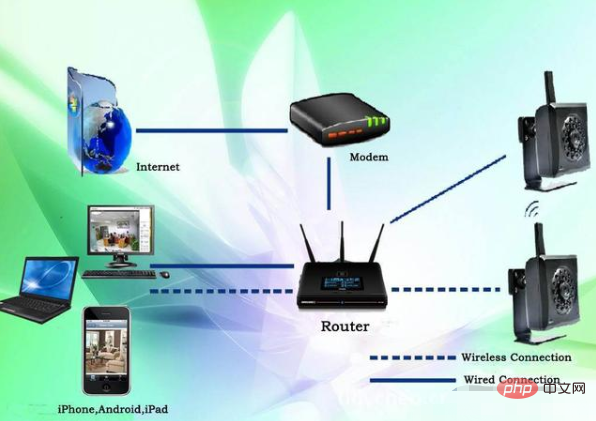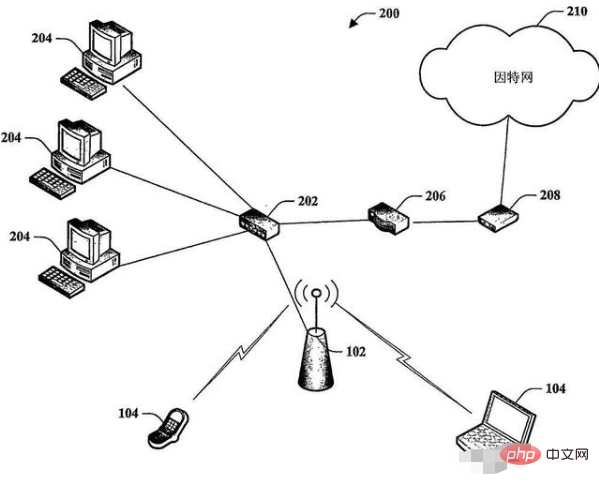Home >Common Problem >What is the difference between unlimited LAN and Wi-Fi?
What is the difference between unlimited LAN and Wi-Fi?
- 青灯夜游Original
- 2021-01-02 14:41:4921250browse
Difference: Wireless LAN (WLAN) is a general term, which refers to wireless local area network. All network systems that use wireless communication technology to connect computers or other devices to achieve mutual communication and resource sharing belong to WLAN. Wi-Fi is a wireless networking technology that covers different wireless signal ranges.

#The operating environment of this tutorial: Windows 7 system, Dell G3 computer.
What is the difference between unlimited LAN and Wi-Fi?
What is the difference between unlimited LAN and Wi-Fi? In fact, the two have a relationship of inclusion and inclusion. Wireless local area network (WLAN) includes wireless hotspot (Wi-Fi). WLAN is a general term that refers to wireless local area networks. All network systems that use wireless communication technology to connect computers or other devices to achieve mutual communication and resource sharing belong to WLAN, and Wi-Fi is a wireless networking technology.

WLAN is the abbreviation of Wireless Local Area Network. Its essential feature is that it no longer uses traditional cables to connect devices, but uses a more flexible and convenient wireless method, because WLAN has Strong mobility, flexibility and convenience. The use of electromagnetic wave technology to connect communications in space has greatly improved user convenience.

Wi-Fi is essentially a wireless LAN technology based on the IEEE 802.11 standard. It also uses radio waves to access the Internet. Our most common Wi-Fi devices are wireless The router can quickly realize Internet connection sharing in the home wireless network through the router's built-in DHCP client, Network Address Translation (NAT) and other functions. All devices under the same Wi-Fi actually form a wireless LAN.
Wi-Fi can be said to be the most widely used wireless network transmission technology at this stage. Almost all Internet-connected devices such as mobile phones and tablets support this technology. Wi-Fi technology can be simply understood as converting wired network signals into wireless network signals, so that devices can be interconnected through wireless wires. The biggest advantage is that there is no need to connect devices through cables, and the transmission power is low, making it very suitable for office use. and family environment.
Because Wi-Fi is a technology included in WLAN, it can be said that WLAN has a wide range of applications, ranging from homes to enterprises to metropolitan area networks. Home wireless WLAN can be regarded as the simplest application. Devices access Internet resources through wireless hotspots generated by routers. It also allows enterprises to establish cross-building WLAN networks in multiple buildings through bridging.
WLAN can use two or more components of the device to be combined to form a multi-level, wireless and wired computer network. Wi-Fi actually provides a way to interconnect various terminals using wireless connections, while shielding users from the differences between various devices.
The difference between wireless LAN and Wi-Fi
1. WiFi is included in wireless LAN, with different power of transmitting signals and different coverage areas
In fact, WIFI is a trademark of WL ANA (Wireless LAN Alliance). This trademark only guarantees that products using this trademark can cooperate with each other. It has nothing to do with the standard itself. However, because WIFI mainly uses the 802.11b protocol, people gradually It is customary to use WIF to refer to the 802.11b protocol.
In terms of inclusion relationship, WIFI is a standard of WLAN. WIFI is included in WLAN and is a new technology that adopts WLAN protocol. The coverage range of WiFi can reach about 300 feet (about 90 meters), and the maximum WLAN (with antenna) can reach 5KM.
2. The covered wireless signal range is different
WIFI (Wireless Fidelity), also known as the 802.11b standard, its biggest advantage is its high transmission speed, which can reach 11Mbps, and its effective distance It is also very long and compatible with various existing 802.11DSSS devices. Wireless Internet access has become a reality.
Radio waves have a wide coverage range. The coverage range of radio waves based on Bluetooth technology is very small, with a diameter of only about 50 feet or 15 meters, while the radius of Wi-Fi can reach about 300 feet or 90 meters. . However, with the development of wifi technology, wifi signals will cover a wider range in the future.
If you want to read more related articles, please visit PHP Chinese website! !
The above is the detailed content of What is the difference between unlimited LAN and Wi-Fi?. For more information, please follow other related articles on the PHP Chinese website!

